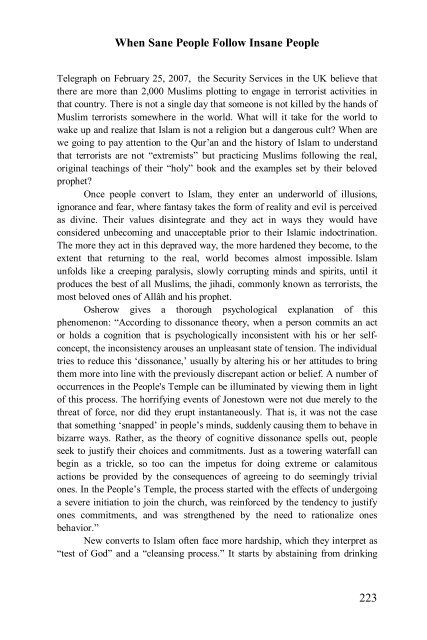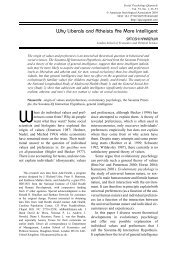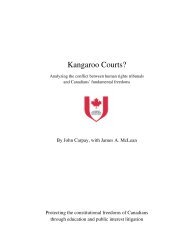Ali Sina - Understanding Muhammad
Ali Sina - Understanding Muhammad
Ali Sina - Understanding Muhammad
You also want an ePaper? Increase the reach of your titles
YUMPU automatically turns print PDFs into web optimized ePapers that Google loves.
When Sane People Follow Insane People<br />
Telegraph on February 25, 2007, the Security Services in the UK believe that<br />
there are more than 2,000 Muslims plotting to engage in terrorist activities in<br />
that country. There is not a single day that someone is not killed by the hands of<br />
Muslim terrorists somewhere in the world. What will it take for the world to<br />
wake up and realize that Islam is not a religion but a dangerous cult When are<br />
we going to pay attention to the Qur’an and the history of Islam to understand<br />
that terrorists are not “extremists” but practicing Muslims following the real,<br />
original teachings of their “holy” book and the examples set by their beloved<br />
prophet<br />
Once people convert to Islam, they enter an underworld of illusions,<br />
ignorance and fear, where fantasy takes the form of reality and evil is perceived<br />
as divine. Their values disintegrate and they act in ways they would have<br />
considered unbecoming and unacceptable prior to their Islamic indoctrination.<br />
The more they act in this depraved way, the more hardened they become, to the<br />
extent that returning to the real, world becomes almost impossible. Islam<br />
unfolds like a creeping paralysis, slowly corrupting minds and spirits, until it<br />
produces the best of all Muslims, the jihadi, commonly known as terrorists, the<br />
most beloved ones of Allâh and his prophet.<br />
Osherow gives a thorough psychological explanation of this<br />
phenomenon: “According to dissonance theory, when a person commits an act<br />
or holds a cognition that is psychologically inconsistent with his or her selfconcept,<br />
the inconsistency arouses an unpleasant state of tension. The individual<br />
tries to reduce this ‘dissonance,’ usually by altering his or her attitudes to bring<br />
them more into line with the previously discrepant action or belief. A number of<br />
occurrences in the People's Temple can be illuminated by viewing them in light<br />
of this process. The horrifying events of Jonestown were not due merely to the<br />
threat of force, nor did they erupt instantaneously. That is, it was not the case<br />
that something ‘snapped’ in people’s minds, suddenly causing them to behave in<br />
bizarre ways. Rather, as the theory of cognitive dissonance spells out, people<br />
seek to justify their choices and commitments. Just as a towering waterfall can<br />
begin as a trickle, so too can the impetus for doing extreme or calamitous<br />
actions be provided by the consequences of agreeing to do seemingly trivial<br />
ones. In the People’s Temple, the process started with the effects of undergoing<br />
a severe initiation to join the church, was reinforced by the tendency to justify<br />
ones commitments, and was strengthened by the need to rationalize ones<br />
behavior.”<br />
New converts to Islam often face more hardship, which they interpret as<br />
“test of God” and a “cleansing process.” It starts by abstaining from drinking<br />
223






